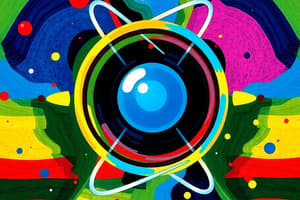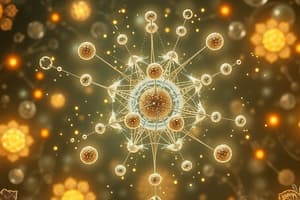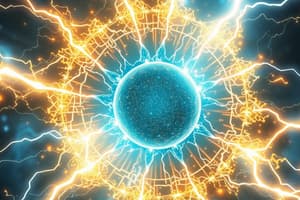Podcast
Questions and Answers
What distinguishes one atom from another?
What distinguishes one atom from another?
- Different numbers of protons
- Different types of electrons
- Different masses of atoms
- Different numbers of sub-atomic particles and their arrangement (correct)
Which of the following statements about elements is true?
Which of the following statements about elements is true?
- Each element possesses unique characteristics. (correct)
- An element is composed of multiple types of atoms.
- Elements can be broken down into simpler substances.
- There are more than 100 known compounds.
Which sub-atomic particle carries a positive charge?
Which sub-atomic particle carries a positive charge?
- Neutron
- Electron
- Positron
- Proton (correct)
Matter is defined as anything that:
Matter is defined as anything that:
What is formed when one or more elements chemically combine?
What is formed when one or more elements chemically combine?
How can elements be compared to letters in the alphabet?
How can elements be compared to letters in the alphabet?
What state of matter is NOT one of the three primary states mentioned?
What state of matter is NOT one of the three primary states mentioned?
Which of the following best describes an atom?
Which of the following best describes an atom?
What is the approximate mass ratio of protons to electrons?
What is the approximate mass ratio of protons to electrons?
Which particles make up the nucleus of an atom?
Which particles make up the nucleus of an atom?
What defines the atomic number of an element?
What defines the atomic number of an element?
When a molecule loses its chemical properties, what is it called?
When a molecule loses its chemical properties, what is it called?
What happens to an electron when it absorbs energy?
What happens to an electron when it absorbs energy?
Which of the following accurately describes a molecule of oxygen?
Which of the following accurately describes a molecule of oxygen?
What signifies an atom being neutral?
What signifies an atom being neutral?
What is the role of shells in atomic structure?
What is the role of shells in atomic structure?
Flashcards are hidden until you start studying
Study Notes
Matter and Elements
- Matter is anything that occupies space and has weight, e.g., air, water, clothing, animals, and the human body.
- Matter exists in three states: solid, liquid, and gaseous.
- An element is a substance that cannot be broken down into simpler substances, such as gold, silver, oxygen, and iron.
- Over 100 known elements combine to form various compounds encountered in daily life.
- Compounds are formed when one or more elements chemically combine (e.g., salt is sodium and chlorine, water is hydrogen and oxygen).
Structure of the Atom
- Atoms are the smallest particles that represent the characteristics of elements.
- Each atom is composed of electrons, protons, and sometimes neutrons, known as sub-atomic particles.
- The identity of an atom is determined by the number and arrangement of its sub-atomic particles.
- Protons have a positive charge, electrons have a negative charge, and neutrons are neutral, with protons being significantly more massive than electrons.
- The atomic nucleus contains protons and neutrons, while electrons orbit around the nucleus.
- Elements are classified by atomic number, which is the number of protons: hydrogen (atomic number 1) and helium (atomic number 2).
- Neutral atoms have an equal number of protons and electrons, resulting in no overall charge.
Molecules
- The smallest unit of a substance retaining its chemical properties is called a molecule.
- Molecules are composed of two or more atoms; elements can consist of identical atoms, such as a diatomic oxygen molecule (O₂).
- Compounds consist of different types of atoms, like a water molecule (H₂O) made of one oxygen and two hydrogen atoms.
Energy Levels
- Electrons occupy orbits around the nucleus, defined as shells that correspond to specific energy levels.
- Under normal conditions, electrons fill the lowest energy shell available.
- When energized, electrons can jump to higher energy shells; however, this state is temporary.
- As electrons return to their original shells, they release energy, illustrating the relationship between electron movement and energy.
Key Concepts
- Atoms and molecules are foundational to the diversity of matter in nature.
- The interaction and combination of sub-atomic particles dictate the properties and classifications of elements and compounds.
- Understanding atomic structure and energy dynamics provides insight into the behavior of matter on a molecular level.
Studying That Suits You
Use AI to generate personalized quizzes and flashcards to suit your learning preferences.




